NETWORKS OF DINING
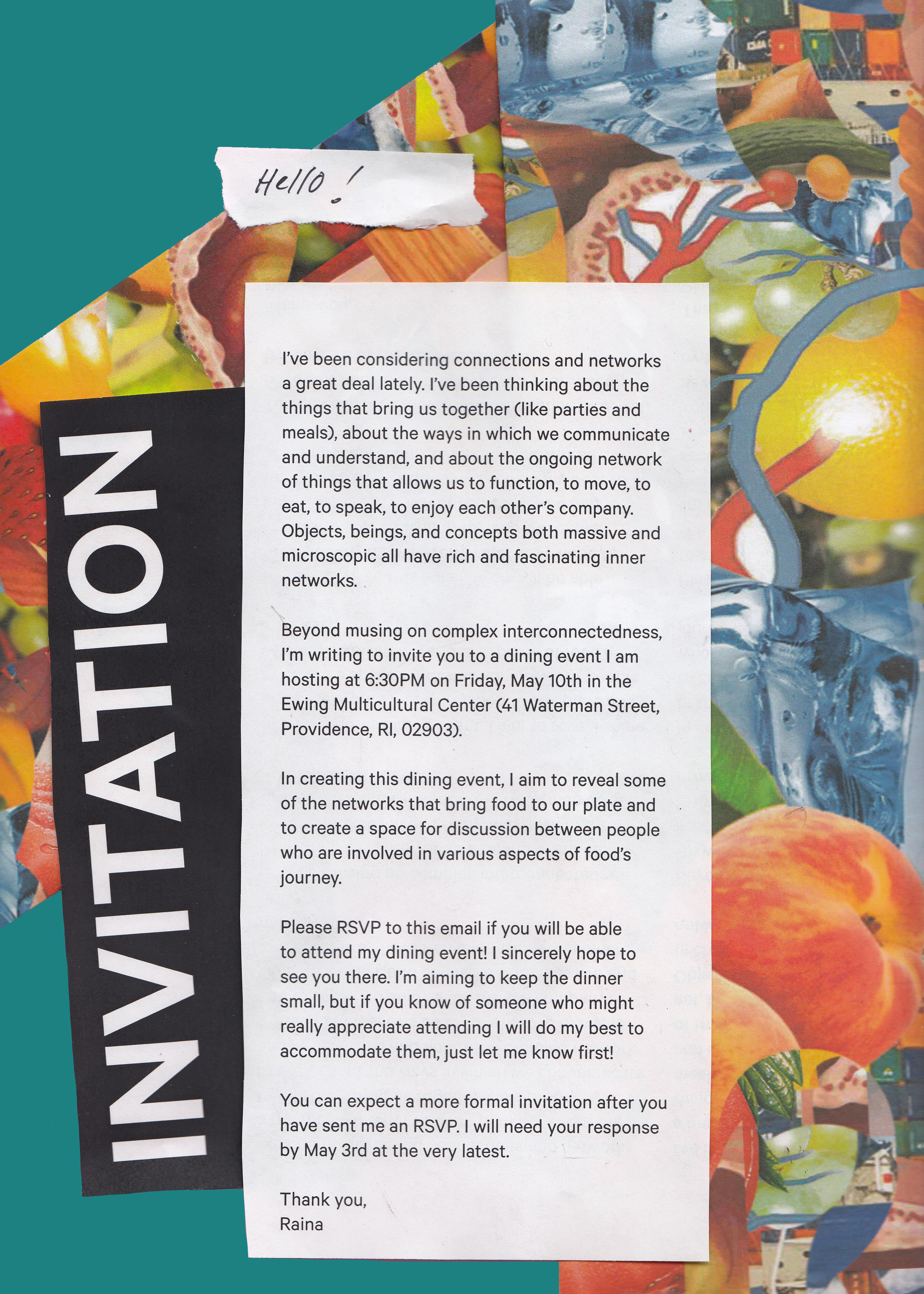
Something as common and casual as eating, particularly with other people, is full of connectivity, networks, and collaboration. By extension, it is also true that every activity people participate in is just as full. I chose to explore the many networks and systems that can be exposed and extended through dining together.
By preparing a dining event, I aimed to create a space for thoughtful, creative conversation and to foster a sense of community and intimacy. Dinners can bring a wide variation of people and foods together and I wanted to utilize this powerful space as a part of my Degree Project. Through the action of planning and creating this dining event I wanted to create a sense of closeness to food systems that is often not considered, especially when in proximity to a student dining hall service.
By preparing a dining event, I aimed to create a space for thoughtful, creative conversation and to foster a sense of community and intimacy. Dinners can bring a wide variation of people and foods together and I wanted to utilize this powerful space as a part of my Degree Project. Through the action of planning and creating this dining event I wanted to create a sense of closeness to food systems that is often not considered, especially when in proximity to a student dining hall service.

Above, one of the ceramic dishes made in collaboration with Maria Gerdyman holding an assortment of pickles I prepped with Aiyu Liang.


On the left, an invitation I sent out to all of my guests. Each dinner party guest was invited because of their involvement in food related projects or inquiry. Above, some images of the dinner party spread!
The dining event was about gratitude and connectivity. It could not have ocurred without a great deal of collaboration. Big thanks to Chef David Gould for the immense amount of support and for working with me to cook this meal and to gain greater knowledge about the food systems in which food exists and functions. Thank you to Chef Timothy McFate for a great deal of help with preparation and set up.
Thank you to Maria Gerydman for spending time with me playing with clay, collaborating on the production of the ceramic dishes, and for co-designing and fabricating the dining troughs.
Thank you to Aiyu Liang for spending a whole Friday night pickling with me.
Thank you to the farms that produced the food I served during the meal.
Thank you to Paul Soulellis (my thesis advisor), Sara Park (an artist/designer who uses food in their practice), and Ginnie Dunleavy (the amazing Executive Director of Auxiliary Services), and my parents who have fed me since before I can remember.

Above is a rhubarb crumble and local flowers as well as a napkin, series of menus, and set of questioneers all designed by me.
By collaborating with RISD Dining Services I was able to connect with a rich network of people involved in various food processes. I was also able to learn about the interesting tool of purchasing power, one of the many methods that can bring positive change to local and sustainable food systems. Due to the size of RISD’s dining program, RISD Dining Services is able to use economic clout to support local systems of food production, creating a positive impact economically and environmentally.

In collaboration with the Executive Chef David Gould of RISD Dining, I worked to create a menu that could be produced in the Metcalf Refectory alongside the normal processes that occur in the dining hall kitchen. I wanted to serve spring tastes (like fiddleheads) and primarily locally sourced food. I kept other types of sourced foods in the mix as well, like strawberries, in part to highlight the ways in which we rely on a problematic system of food delivery and production. The meal was four courses and consisted of sautéed fiddleheads, pickled fruits and vegetables, local greens sautéed with roasted maitake mushroom, farro salad, green asparagus salad, lemon grilled halibut, rhubarb crisp, fresh mint tea, and pickled strawberry shrub drink.

Chef David Gould with the rhubarb crumble in the Met Kitchen.

Fish prep for the dining event in the Met Kitchen.
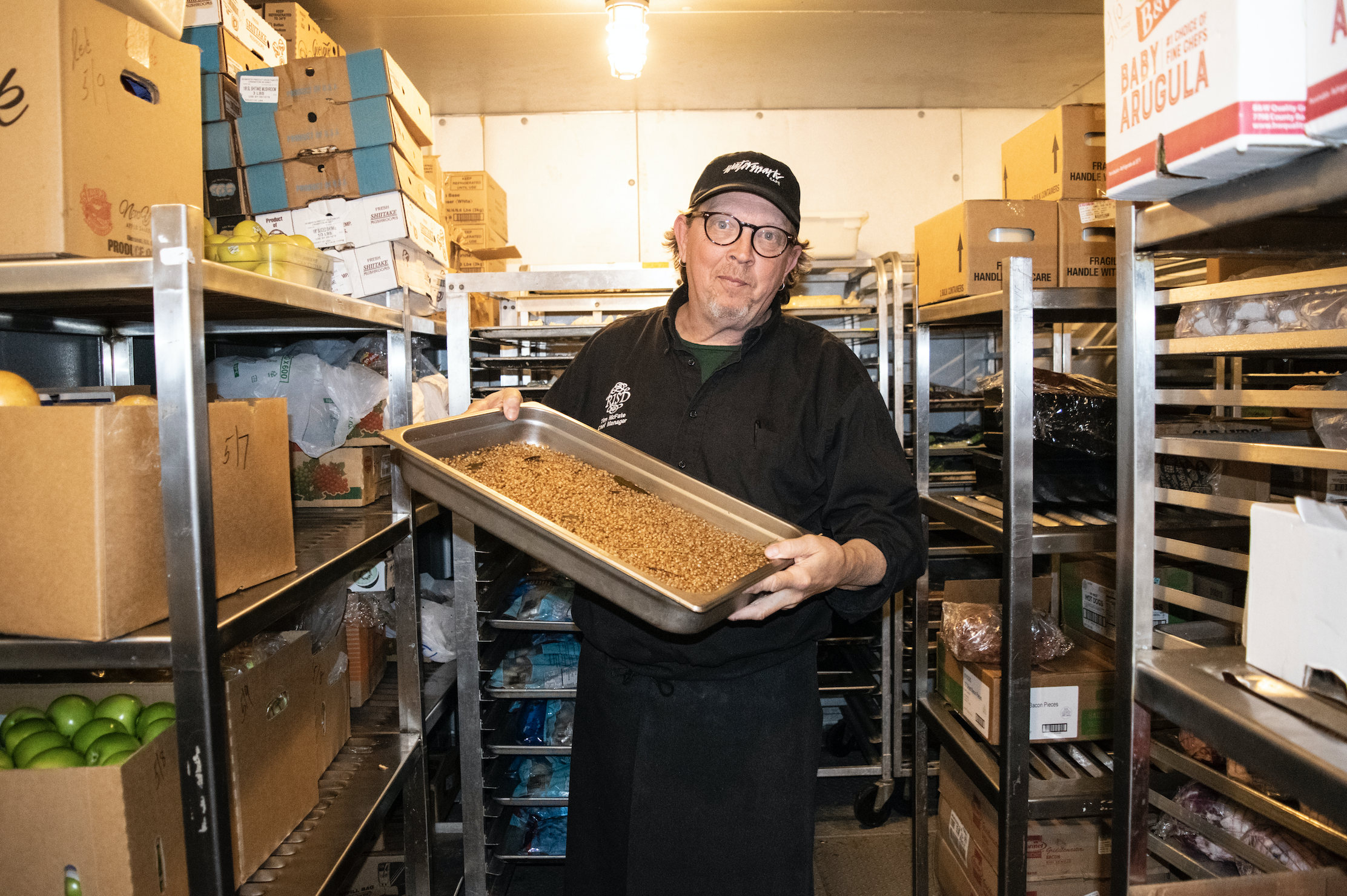
Chef Timothy McFate with farro salad in the Met walk-in fridge.

Behind-the-scenes in the met kitchen! Many ladles!

An image of fiddlehead preparation in the Met Kitchen.

Pickled strawberry and seltzer drink created for the dining event.
It was interesting working to create a small scale dining experience within a space built to be able to host a large scale cooking operation. The behind-the-scenes experience was also quite revealing. The impact of my project ended up affecting the dining hall at large. They served farro and fiddelheads to RISD students at the Met a few days after my event. Essentially, my little menu resulted in large, local purchases.
Having the opportunity to see the tools and meet the people who have been cooking for me for the past 4 years was really valuable. This opportunity, to be immersed in a space that many don’t get to witness, inspired me to think of other additional ways (besides the dining event that I organized) in which food systems could and should be revealed.
The graphic and artistic elements had an important role in the event as well. I created a tablecloth, a menu, and collaborated on a series of serving dishes, all details that helped to take the event to a more refined and immersive level. For the graphic imagery on both the tablecloth and the menu I chose to create a special kind of diagram, one that represented the complicated, interwoven, and extensive system of networks that go on behind the scenes.
The journey of food is an incredibly interesting and diverse one. It relies on special soil conditions, hardworking worms, complicated science, temperature, farming practices, distribution, culinary arts, design, and presentation.
![]()
Everyone who I invited to the “Dining Together” event was part of my network and were people who worked with food, studied food, or created community events using food. I wanted the dinner to serve as a way for these guests to meet and talk with people with similar, but also different passions and perspectives. As part of the dining event I asked each guess to fill out a form responding to questions that were brought up in the menu. Guests also chose to answer the questions out loud during the dinner, allowing for interesting tangents of food related discussion.
The Questions
![]()
Having the opportunity to see the tools and meet the people who have been cooking for me for the past 4 years was really valuable. This opportunity, to be immersed in a space that many don’t get to witness, inspired me to think of other additional ways (besides the dining event that I organized) in which food systems could and should be revealed.
The graphic and artistic elements had an important role in the event as well. I created a tablecloth, a menu, and collaborated on a series of serving dishes, all details that helped to take the event to a more refined and immersive level. For the graphic imagery on both the tablecloth and the menu I chose to create a special kind of diagram, one that represented the complicated, interwoven, and extensive system of networks that go on behind the scenes.
The journey of food is an incredibly interesting and diverse one. It relies on special soil conditions, hardworking worms, complicated science, temperature, farming practices, distribution, culinary arts, design, and presentation.

Everyone who I invited to the “Dining Together” event was part of my network and were people who worked with food, studied food, or created community events using food. I wanted the dinner to serve as a way for these guests to meet and talk with people with similar, but also different passions and perspectives. As part of the dining event I asked each guess to fill out a form responding to questions that were brought up in the menu. Guests also chose to answer the questions out loud during the dinner, allowing for interesting tangents of food related discussion.
The Questions
1. How does food relate to your personal practice?
2. What do you wish you knew about the food you eat?
3. What are your first food memories?
4. What are your biggest concerns relating to food?
5. What are your favorite things about food?
6. What do you envision is the future of food?
7. How can we make the systems of food more visible?
8. Do you think it is important to have greater exposure to the complex processes
that go on behind dining?
9. Any other reflections on food...
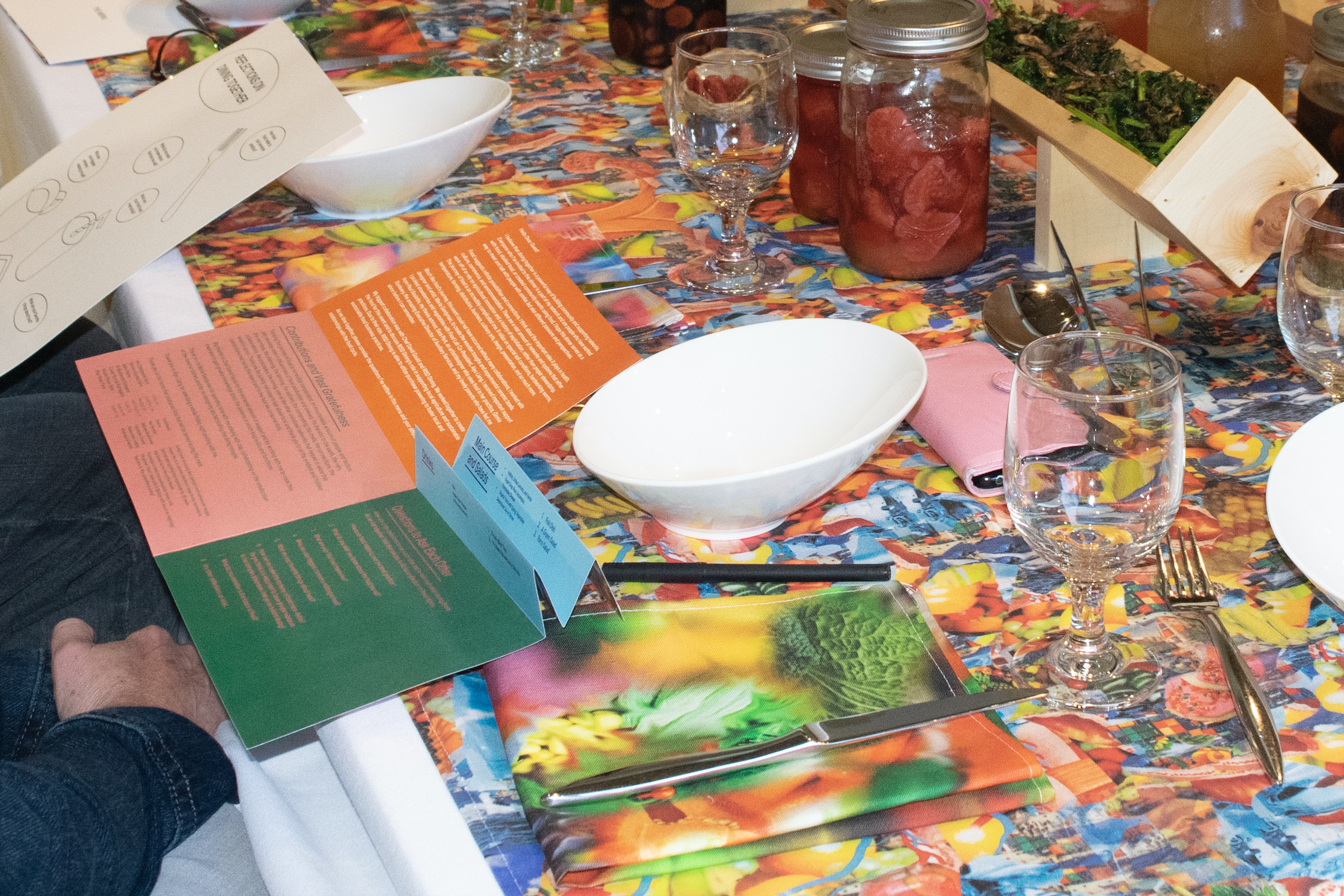

Folding menu with details on the project, the farms, and what was served the dining event.

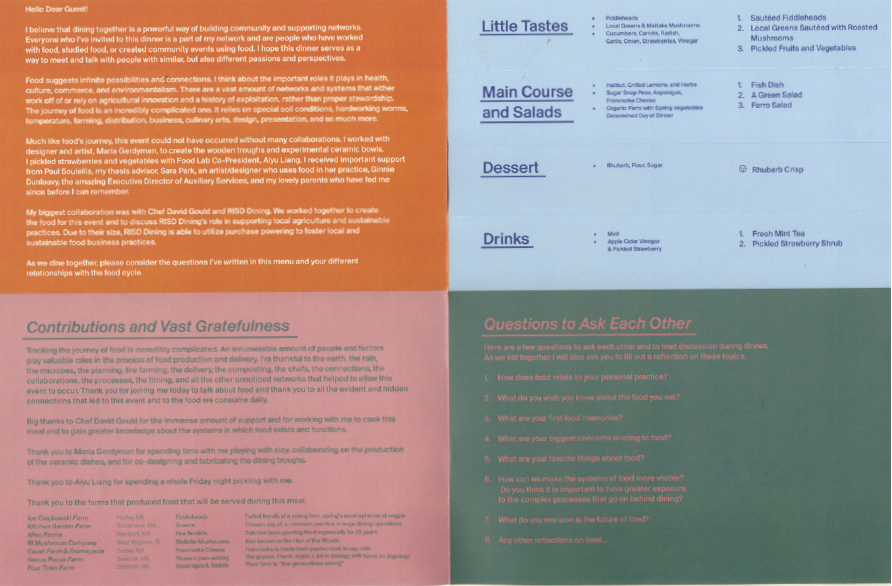
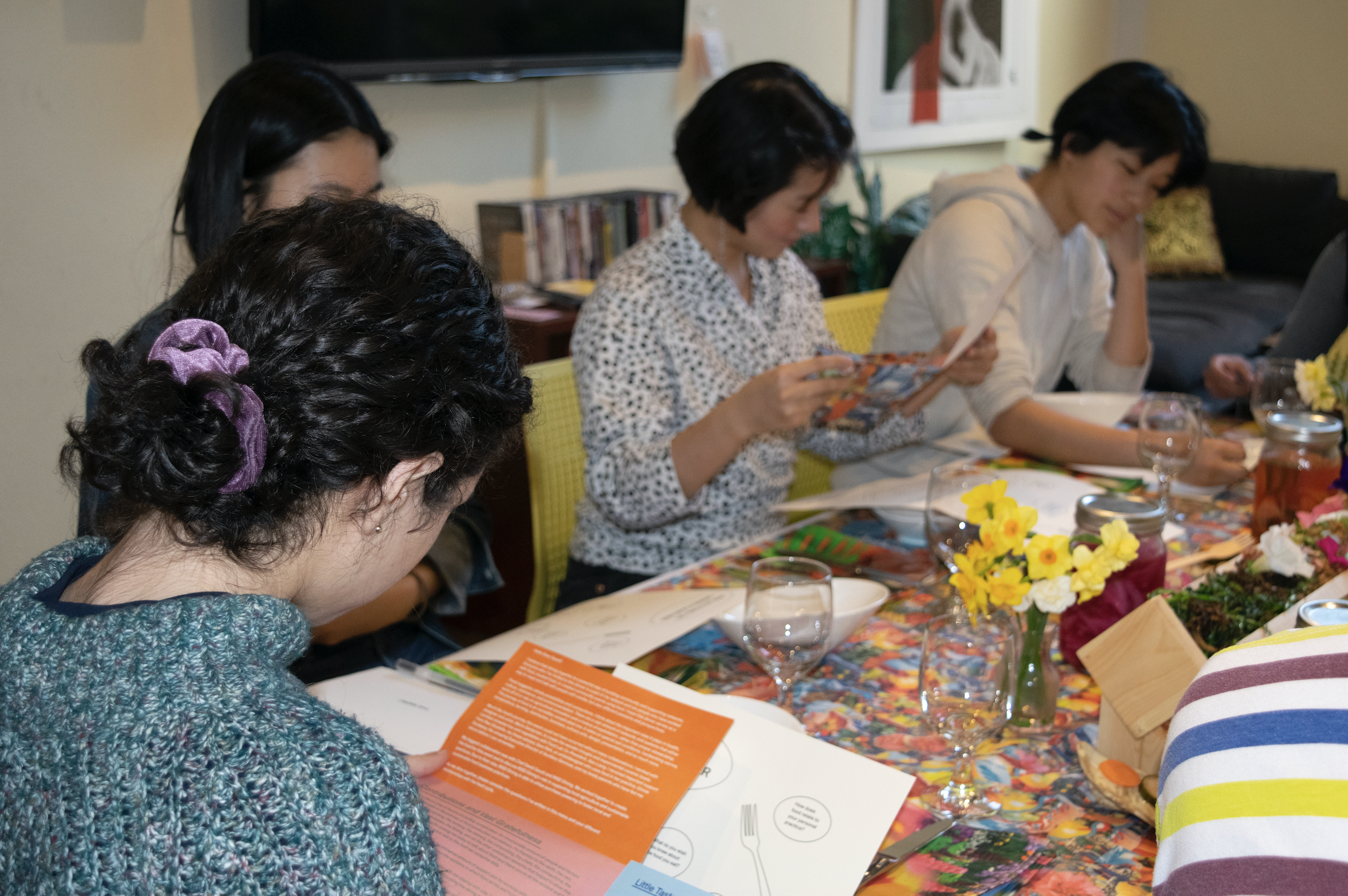
Through the conversations and the graphic elements I wanted to emphasize and discuss how being aware of the journey of food is incredibly important. An innumerable amount of people and factors play valuable roles in the process of food production and delivery and we need to think of new ways to support them and work with them to respond to climate change and social justice issues.
I also wanted to create a space of gratefulness to the earth, the rain, the microbes, the planning, the farming, the delivery, the composting, the chefs, the connections, the collaborations, the processes, the timing, and all the other unnoticed networks that helped to allow the event to occur.
I also wanted to create a space of gratefulness to the earth, the rain, the microbes, the planning, the farming, the delivery, the composting, the chefs, the connections, the collaborations, the processes, the timing, and all the other unnoticed networks that helped to allow the event to occur.
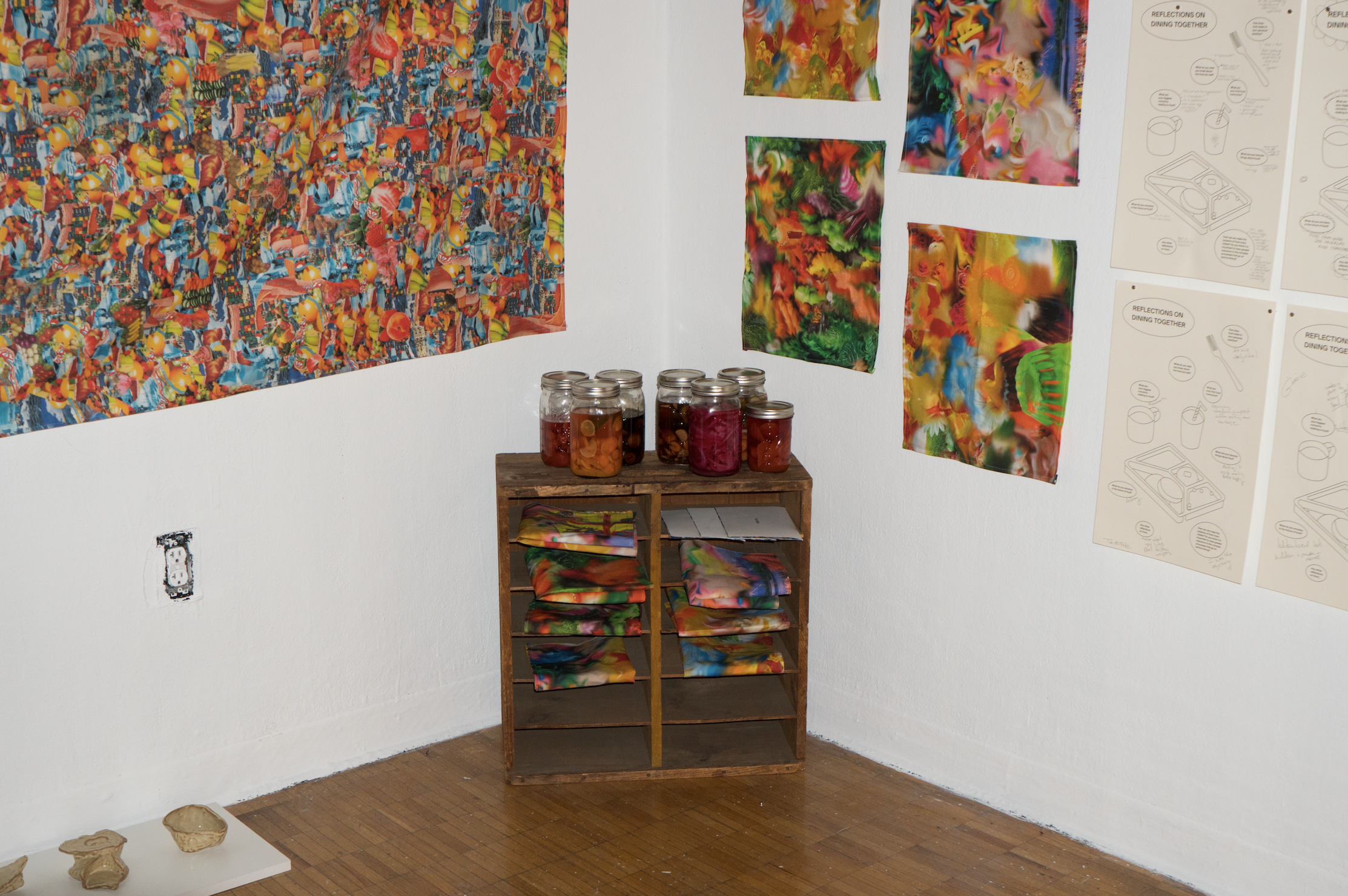
The components and remenants of my Networks of Dining Event were on display at my thesis exhbition. I also provided a selection of RISD Food Lab pickled strawberries, red onions, cucumbers, carrots, and radishes.

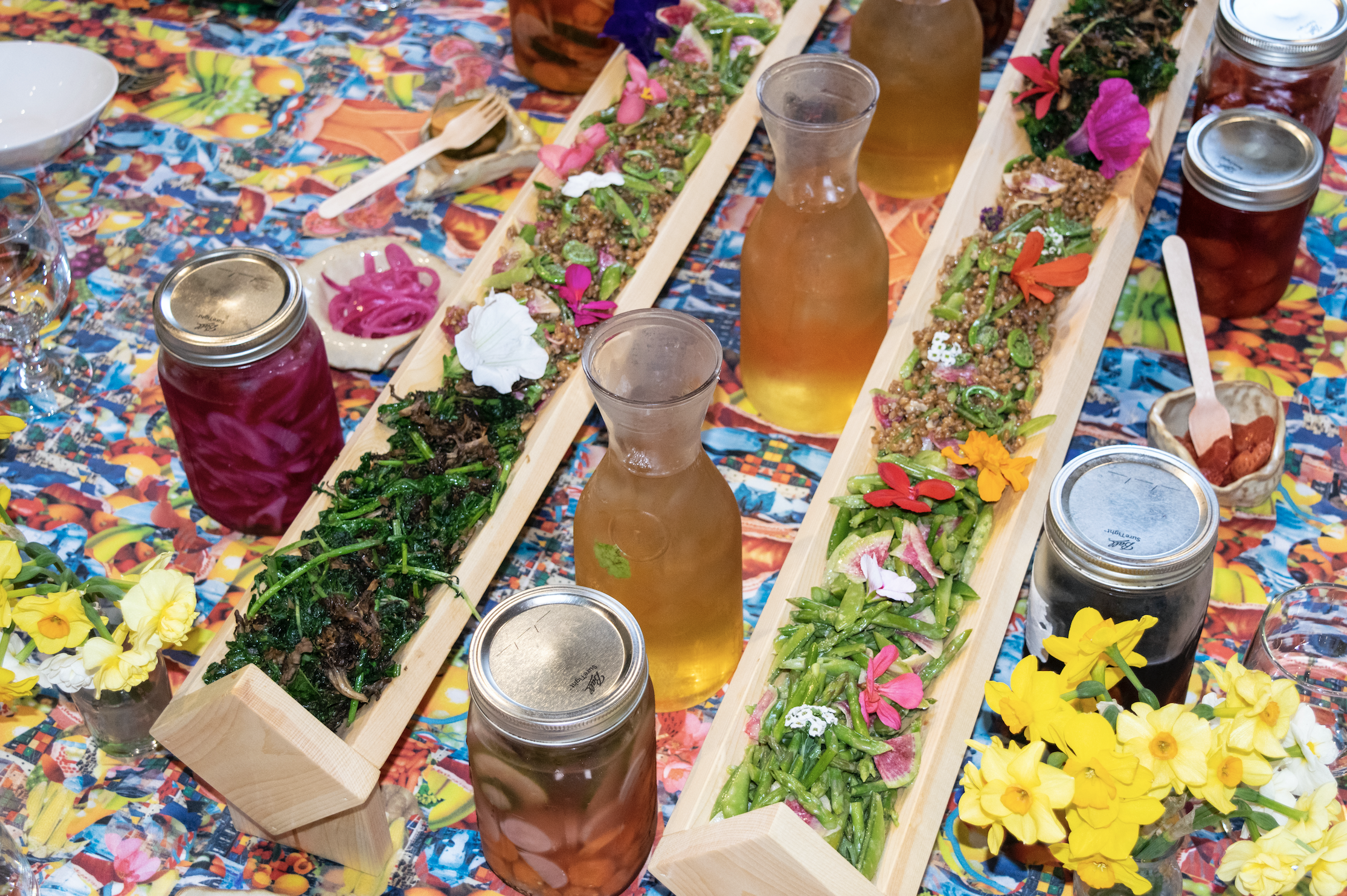
The tablecloth and napkins were designed by me and printed using a grant from Spoonflower. I wanted to illustrate the complex interconnectivity of food even on the textile components of the event.
The dinner ware (including the wooden troughs and ceramic dishes) were designed and created in collaboration with Maria Gerdyman.
The dinner ware (including the wooden troughs and ceramic dishes) were designed and created in collaboration with Maria Gerdyman.